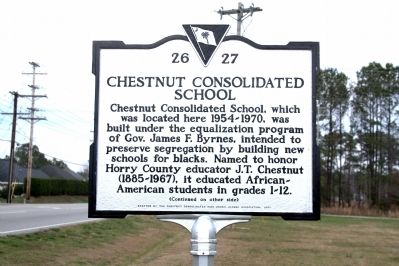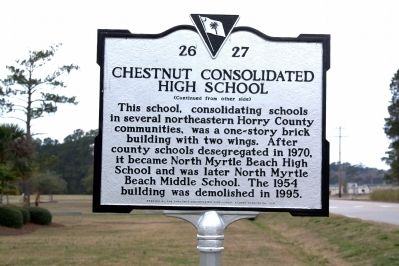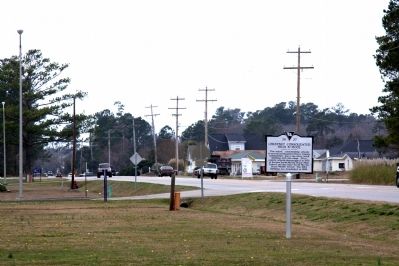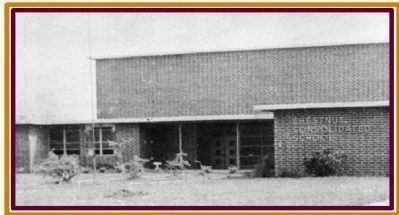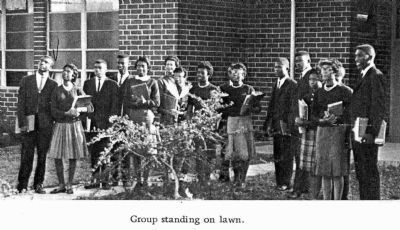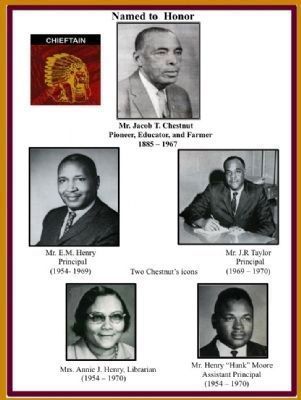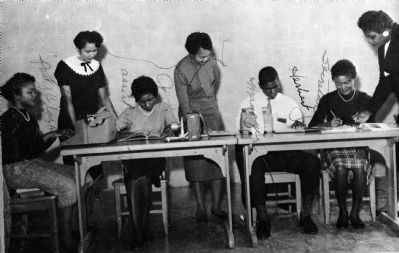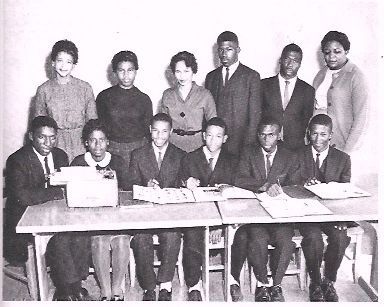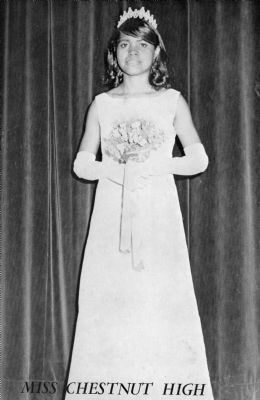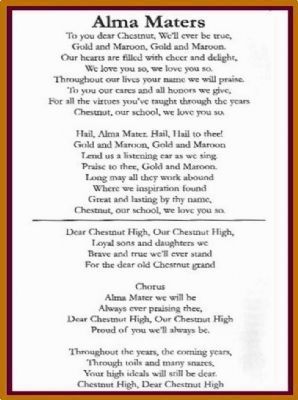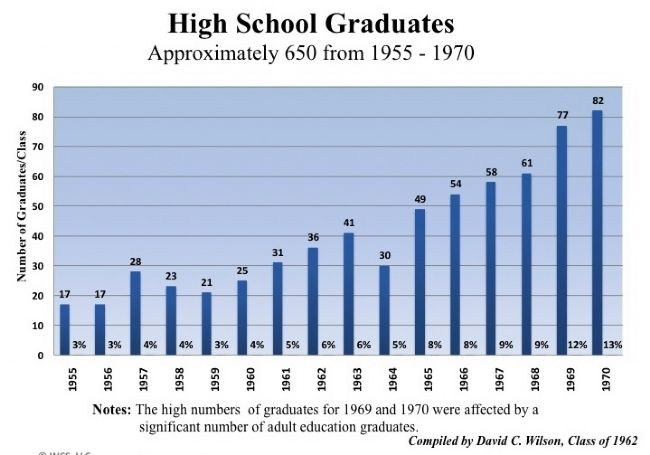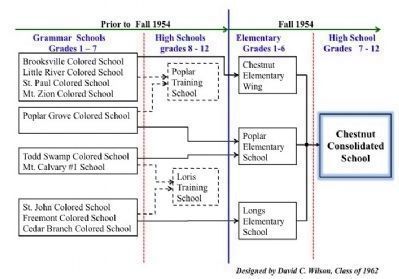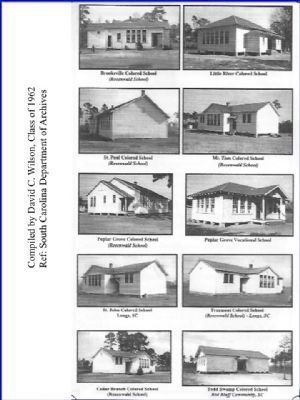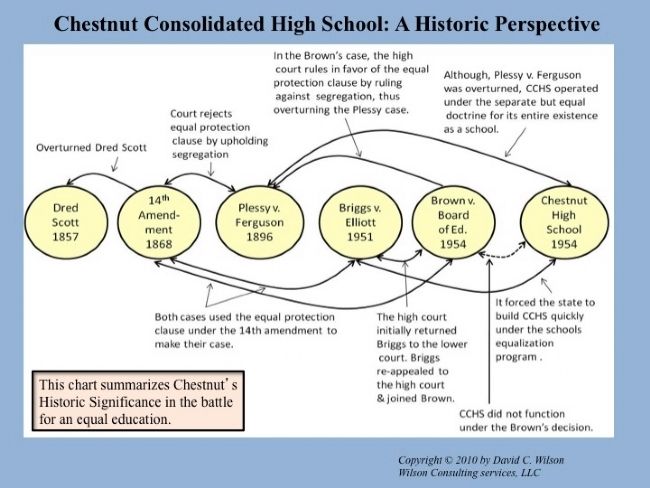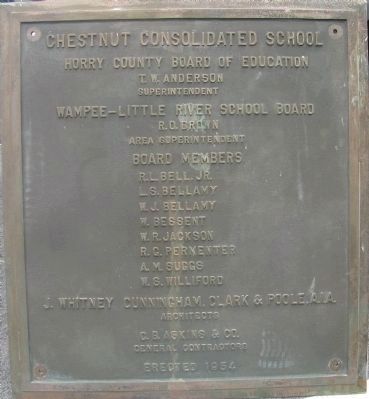Near Little River in Horry County, South Carolina — The American South (South Atlantic)
Chestnut Consolidated School
This school, consolidating schools in several northeastern Horry County communities, was a one-story brick building with two wings. After county schools desegregated in 1970, it became North Myrtle Beach High School and later North Myrtle Beach Middle School. The 1954 building was demolished in 1995.
Erected 2011 by The Chestnut Consolidated High School Alumni Association. (Marker Number 26-27.)
Topics. This historical marker is listed in these topic lists: African Americans • Education. A significant historical year for this entry is 1970.
Location. 33° 51.191′ N, 78° 40.765′ W. Marker is near Little River, South Carolina, in Horry County. Marker is at the intersection of State Highway 90 and Edge Road, on the left when traveling west on State Highway 90. Marker is in the northeast corner of the North Myrtle Beach Middle School grounds. Touch for map. Marker is in this post office area: Little River SC 29566, United States of America. Touch for directions.
Other nearby markers. At least 8 other markers are within 6 miles of this marker, measured as the crow flies. Fort Randall (approx. 1½ miles away); Roberts Pavilion / Ocean Drive Pavilion (approx. 2.4 miles away); Sonny’s Pavilion (approx. 2.7 miles away); Atlantic Beach (approx. 4 miles away); Rebecca Randall Bryan (approx. 4.1 miles away); Rev. George Whitefield (approx. 4.1 miles away); Boundary House (approx. 5½ miles away); South Carolina / North Carolina (approx. 5.8 miles away in North Carolina). Touch for a list and map of all markers in Little River.
Also see . . . History of NMBHS. “The new school brought together children from Atlantic Beach, Little River, Little River Neck, Brooksville, Mt. Calvary and Longs. Before this school, Little River Neck had a school in a church and Little River had its own little school with two or three teachers. School busses started making routes for the black children in 1950. Before this, Mr. Chestnut went out in his own personal bus to pickup the children. Children that lived in Little River Neck had to walk to Nixon’s Crossroads to meet the bus. ” (Submitted on February 11, 2012.)
Additional commentary.
1. A Historic Perspective
The journey to the establishment of Chestnut Consolidated School can be traced back to the Dred Scott decision of 1857 by the U.S. Supreme Court that slavery was legal. In 1868 the 14th amendment to the U.S. Constitution was ratified, which defined citizenship and included the equal protection clause, essentially overruling the Dred Scott decision. Once again, another major U.S. Supreme court case known as Plessey versus Ferguson (1896) resulted in the separate but equal doctrine for blacks and whites. The segregation part of the law was complied with, but the equal part was a dismal failure.
In the ensuing years, Mr. Julius Rosenwald, a New York philanthropist, partnered with the incomparable Dr. Booker T. Washington in 1911 to perform a public service of the highest order. Together they made a contribution of enduring value, which changed the course of American history. It been called the “most influential philanthropic force that came to the aid of Negroes at that time.” It eventually provided seed grants for the construction of more than 5,300 buildings in 15 states, including schools, shops, and teachers’ houses, which were built by and for African Americans. Most of these school buildings are gone as would be expected because of changing times. Six of the eleven community schools that became feeders to Chestnut Consolidated School were Rosenwald Schools. The Rosenwald initiative had four parts raised enough funds to build schools. The four parts were: 1) Rosenwald appropriation, 2) white contribution, 3) Negro contribution [local community] and 4) public contribution. Prior to and during the Rosenwald initiative, children living in rural areas attended classes were in their local churches. Even after this initiative, many children continued to attend school in their local churches until the early 1940’s.
The typical school community during this period was a two room wood structure, with outdoor toilets and some form of drinking water usually a hand water pump located on the school ground. The schools housed grades 1- 7 and some included up to eight grades. Few teachers at the time had four-year college degrees. Most of all, in spite of this and other efforts, the lack of resources resulted
in a poor education outcomes for blacks.
Each step along the way resulted in an improvement in education for African Americans. Poplar and Loris Training Schools did not have a gymnasium. Many African American high schools during this period in the south were considered training schools, rather than high schools. Many of these training schools only added 12th grade in 1948. All competitive sports were played outdoors. There were very few school buses to transport children from their local communities to either of these two schools. Often, in order for a student to attend high school, he/she would need to board with a family living near one of these two schools. Some of the students from this area boarded with families in Conway in order to attend Whittemore High School.
On December 22, 1950, Mr. Harry Briggs of Clarendon County filed a lawsuit in federal lawsuit filed in Federal District Court challenging the constitutionality of the state’s “separate but equal” education provision. As the Briggs vs. Elliott case and three other similar cases played out in the courts, including Brown vs. Topeka Kansas Board of Education, South Carolina passed a three-cent sales to fund a statewide program of school constructions in order to finance the equalization program, which was designed to equalize white and black public schools. On December18, 1953, The Myrtle Beach Sun reported that two Negro Schools would be constructed in Horry County, one was Finklea at a cost of $422,000 and one in Wampee (Chestnut was not yet named at the time) at a cost of $214,000 on 18 acres between Nixon Crossroads and Wampee. Chief Justice Earl Warren combined Briggs and others with the Brown case. On May 17, 1954, the Brown vs. Board of Education case in a nine to zero decisions the U.S. Supreme Court ruled that segregation of the schools violated the “Equal Protection Clause” under the Fourteenth Amendment; and was therefore, unconstitutional.
In the fall of 1954, Chestnut Consolidated School opened its doors as a school. It was located on the current site of North Myrtle Beach Middle School. It was built under the equalization program of Gov. James F. Byrnes, intended to preserve segregation by building new schools for blacks. The school was named in honor of a prominent Horry County educator, Mr. Jacob T. Chestnut (1885 – 1967). It educated African-American students in grades 1 – 12. The establishment of the school in 1954, consolidating
schools in several northeastern Horry County communities, was a one story brick building with two wings, one for middle and high school students and the second for elementary students. Longs Elementary and Poplar Elementary Schools (grades 1 – 6) were feeders to Chestnut Consolidated School. The newly established school brought together children from Atlantic Beach, Little River, Little River Neck, Brooksville, Mt. Calvary#1, Red Bluff, Cedar Branch, and Longs. There were only three black high schools in Horry County during this period. The school colors were gold and maroon, and its mascot was “CHIEFTAIN.”
In 1957 after being open for only three years, the school won the state championship in basketball. In the fall of 1963, a football team was established. As part of the curriculum, the school had two well organized programs known as New Farmers of America (N.F.A.) for the male students under the leadership of the Mr. James F. Fitts and New Homemakers of America (N.H.A.) under the leaderships of the late Gladys Murray and Mrs. Bessie E. Ridgley (Malloy). These organizations were the counterpart to Future Farmers of America (F.F.A.) and Future Homemakers of America (F.H.A.) that white students had in their schools. These programs were not as academically challenging as some other courses. They gave the opportunity to model real-life situations and have had a lasting effect on those who completed the N.F.A or N.H.A. programs. For the first 10 years, despite the equalization program, Chestnut Consolidated High School curriculum was minimal. There were four units of English, but courses in mathematics ended in 10th grade with Algebra. There were no offerings in geometry, trigonometry, algebra II or physics. There were no advanced placement courses. The curriculum improved in the mid-sixties with offering many of the courses not previously offered. The Southern Association of Colleges and Schools (SACS) subsequently accredited the school in 1969. SACS is one of seven regionally accrediting agencies in the United States and it is significant to be accredited by one of them. Nevertheless, graduates of the school went on to become productive citizens, including many, that became teachers, doctors, nurses, attorneys, engineers, senior military officers, business executives, and entrepreneurs.
There are a substantial number of graduates that are veterans. The majority of these veterans served in the Vietnam War. Chestnut lost three of its graduates in the Vietnam War.
After Horry County Schools desegregated in 1970, Chestnut became North Myrtle Beach High School and later North Myrtle Beach Middle School. The 1954 building was demolished in 1995.
By David C. Wilson President – Class of 1962
— Submitted August 12, 2012, by David C. Wilson of Conway, South Carolina.
2. Alma Matters
Transcription of the text found in Photograph No. 10.
To you dear Chestnut, We’ll ever be true,
Gold and Maroon, Gold and Maroon.
Our hearts are filled with cheer and delight,
We love you so, we love you so.
Throughout our lives your name we will praise.
To you our cares and all honors we give,
For all the virtues you’ve taught through the years
Chestnut, our school, we love you so.
Hail, Alma Mater, Hail, Hail to thee!
Gold and Maroon, Gold and Maroon
Lend us a listening ear as we sing.
Praise to thee, Gold and Maroon.
Long may all they work abound
Where we inspiration found
Great and lasting by thy name,
Chestnut, our school, we love you so.
__________________________________
Dear Chestnut High, Our Chestnut High,
Loyal sons and daughters we
Brave and true we’ll ever stand
For the dear old Chestnut grand.
Chorus
Alma Mater we will be
Always ever praising thee,
Dear Chestnut High, Our Chestnut High
Proud of you we’ll always be.
Throughout the years, the coming years,
Through toils and many snares,
Your high ideals will still be dear.
Chestnut High, Dear Chestnut High.
— Submitted August 19, 2012.
Credits. This page was last revised on November 21, 2020. It was originally submitted on February 11, 2012, by J. J. Prats of Powell, Ohio. This page has been viewed 1,864 times since then and 66 times this year. Photos: 1, 2, 3. submitted on February 11, 2012, by J. J. Prats of Powell, Ohio. 4, 5. submitted on August 6, 2012, by David C. Wilson of Conway, South Carolina. 6, 7, 8, 9. submitted on August 12, 2012, by David C. Wilson of Conway, South Carolina. 10. submitted on August 13, 2012, by David C. Wilson of Conway, South Carolina. 11, 12, 13, 14. submitted on August 12, 2012, by David C. Wilson of Conway, South Carolina. 15. submitted on August 15, 2012, by David C. Wilson of Conway, South Carolina.
